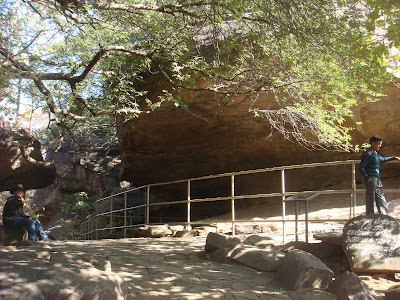Bhimbetka : 10,000 year old wall art
On the hill of Bhimbetka, Madhya Pradesh stands a series of craggy sandstone formations in the form of tall and massive rock shelters. These are the painted rock-shelters that constitute the largest repository of pre-historic art in India. These 10,000 year old wall paintings have been inscribed in the World Heritage List and give us peek into the dawn of history when human beings had just about elevated themselves from a primitive animal existence and were learning to think beyond mere existence and express their thoughts through art forms that have survived till date.
We approach the rock shelters through this tough landscape
We approach the rock shelters through this tough landscape
until we get a first glimpse of our destination ...
These caves were first alluded to by W Kinkaid in 1888 but discovered and conclusively documented by V S Wakankar in 1958.
This is the first of 400 odd shelters that are scattered over the region but of these about 12 - 14 can be accessed relatively easily on foot through trails marked out by the Archaeological Survey of India.
The picture below is the of largest shelter, the Auditorium Cave
that we explored
and where we say our first piece of wall art.
We followed the path laid out by the ASI as follows ...
and saw this beautiful piece where primitive man was trying to hunt an elephant
which is helpfully explained by this ASI graphic
here is another man on top an elephant
following the map we moved through other rock shelters
searching for and finding other pieces of art
as you can see on the top left of the picture above
scenes of battles were painted on the walls and the ceiling
you can see people on horses and with bows and arrows
we moved on and located other shelters like these in the pictures below
where we sat down and tried to imagine what life would have been like 10,000 years ago ... before Ashoka, before the Buddha and even before Harappa and MohenjoDaro, where all our history books begin !
Here were people who for the first time had evolved out of an animal existence of food and procreation and were starting to think and capture their thoughts with paint on the walls of their dwelling
and even thinking of imaginary creatures like this fantastical boar that could not have existed in their midst.
we look further and discover more shelters
each having more examples of the creative spirit that could envisage complex imagery
and scenes of war and epic battles
then we went into another rock shelter
and discovered these pictures of gaiety, of people holding hands and dancing, very reminiscent of the paintings that are used to decorate the walls even today, in tribal villages inhabited by Gonds, Bhils and Santhals just before Diwali.
and you can see the same in this picture below at the top left
we saw pictures of scorpions and deer.
But the biggest collection of wall art awaited us in the "Zoo Rock" that was pointed out by our guide
and you can see the immense collection on the wall behind Wrahool
The Zoo Rock is an amazing rock shelter that would have served as a residence for human beings for thousands, if not millions of years.
This is because you can see a distinct evolution in the technology used to create the art
from the earliest and most primitive art painted in white,
we see more complex stuff painted in new, red or ochre colour
and the drawings get more sophisticated
with new styles being tried out
The name Bhimbetka is associated with the Pandava Prince Bhima who is supposed to have stayed here during their exile and we ended our trip at a small temple dedicated to him, nestled in the rocks.
Bhimbetka is about 40km from Bhopal and can be reached by car. Also near Bhopal but on the other side of the city is another UNESCO World Heritage Site, Sanchi where the Great Stupa built by Emperor Ashoka has been the source of the principal icons that have been adopted by India as its national icons.












































Comments